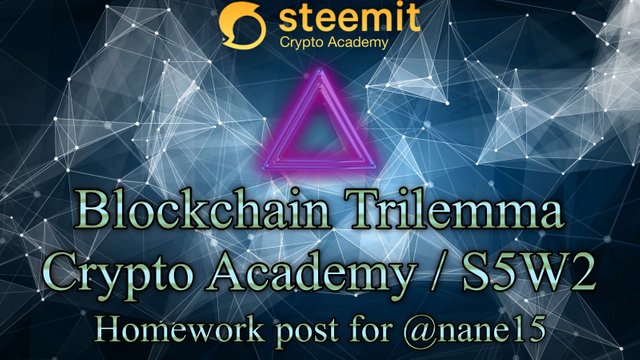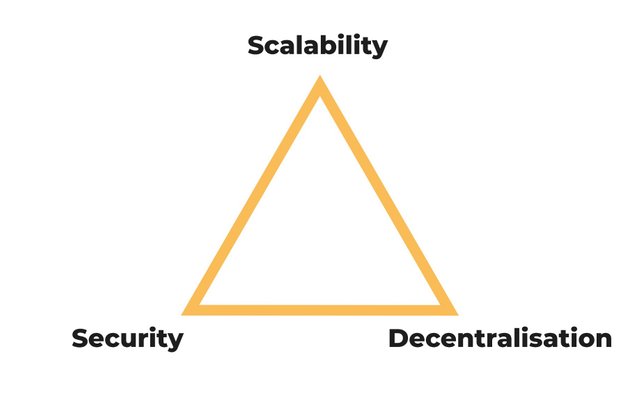Blockchain Trilemma - Crypto Academy / S5W2 - Homework post for @nane15

cover photo made by @sargoon
Hello, Steemit Crypto Academy community! Here I am with my first homework post for Steemit Crypto Academy Beginner courses. In this homework post, I will give you information about the blockchain trilemma. I would like to start my homework by explaining the "What is the Blockchain Trilemma?".

What is the Blockchain Trilemma?

Image Source
First of all, the word "tri(3)"lemma literally has the same logic as the word "di(2)"lemma. With the popularization of Blockchain and the creation of new cryptocurrencies with Blockchain technology, the Blockchain Trilemma emerged. This trilemma is "scalability", "decentralization", and "security". In fact, the concepts found in this trilemma are all components that create blockchain technology, so all three concepts are equally important.
The main reason why scalability, security, and decentralization have become a trilemma for blockchain is that these three important concepts cannot be equal. If you strengthen scalability and decentralization, the security of the blockchain you created will also decrease in this context. Since the concepts in the trilemma do not match with each other, there are inverse proportions between the concepts, so you can keep only two of the components in the trilemma at a high level.
There are some coins that are trying to beat the blockchain trilemma like Algorand, Cardano, and Cudos, but at some point, inconsistencies can arise between the trilemma. Most of today's coins and their associated blockchain projects fail because they cannot overcome the blockchain trilemma.

Is the Blockchain Trilemma Really a Trilemma?
To be honest, yes, the blockchain trilemma is a trilemma. Although blockchain technology is perfect, it has to produce a strong solution to the blockchain trilemma for it to be used all over the world for now. Algorand and Cardano claim to have transcended this trilemma and achieved 33.33% Scalability, 33.33% Security, 33.33% Decentralization by being in the middle of the trilemma triangle. These rates are the rates that all blockchain technologies, especially Ethereum, should reach, but although it is easy to achieve these rates in practice, it is very difficult in practice
In my opinion, the hardest component in the blockchain trilemma is scalability. Due to the large number of new nodes born with increased transactions in cryptocurrencies and the high electricity costs spent, it is very difficult to keep scalability on par with decentralization and security because if scalability increases, security will decrease inversely.
As a result of this, people will stop transacting in blockchains with a high scalability rate due to the conflict that occurs as a result of the Blockchain trilemma, as they will not want to transact in unsecured blockchains.

Define the following concepts in your own words:

Image Source
Decentralization
Decentralization is the cornerstone of blockchain technology and is indispensable. Thanks to the decentralized blockchain, people can trade cryptocurrencies peer to peer without the need for intermediaries. People can securely perform their transactions on decentralized exchanges around the clock, without the need to pay bank employees and additional commission fees.
Decentralization can be used not only in stock markets but also in technologies and institutions that we use in all areas of life. For example, we currently use Steemit to avoid centralized and unreliable social media platforms such as Instagram and Facebook.
Personal data security is at the highest level in decentralized systems, so all your transactions are protected by high-security cryptography encryption methods such as SHA-256 on the nodes in the blockchain.
Blockchain Security
Security is everything in the blockchain. Today, people are not very welcoming because they cannot fully trust blockchain technology. This idea is wrong because, as I mentioned above, thanks to the decentralization feature of blockchain technology, all of your transactions and accounts in the blockchain are protected by cryptography encryption methods in peer-to-peer nodes, making it impossible for hackers to access your personal information and transactions. Since security is of great importance in blockchain, most conscious people who are knowledgeable about blockchain technology and cryptocurrencies use decentralized blockchain technology instead of using centralized systems.
Scalability
Scalability is the biggest and most difficult to solve problem in the blockchain trilemma. To briefly explain the concept of scalability, it is a supply and demand problem. As the demand for cryptocurrencies created by blockchain technology increases, the number of transactions in blockchains increases. For each transaction, a miner, that is, nodes in the blockchain needs to mine blocks. Blockchains fail to scale because they do not have the infrastructure to meet the increasing demand and supply. Blockchains have to compromise on security if they want to be successful at scalability, but they can't because people won't be using blockchains with low security.

Based on your knowledge, explain at least two viable solutions to the challenges posed in the Blockchain Trilemma
The solutions created for the blockchain trilemma are divided into two layers, which are: layer one: on-chain solutions and layer two: off-chain solutions.
Layer 1: on-chain solutions
I will talk about the Hardfork solution, which is one of the most interesting on-chain solutions among the layer one solutions. Hardfork literally means forking, and it happens in almost all advanced blockchains. Hardforks were formerly made to add innovations to blockchains, but with the hardfork on the bitcoin blockchain in August 2017, bitcoin cash was created and separated from the bitcoin blockchain as a separate cryptocurrency and a separate blockchain as a scalability solution. In this way, bitcoin cash transactions by users will no longer burden the main bitcoin blockchain and nodes will only work for main bitcoin transactions.
Layer 2: off-chain solutions
As an example of layer 2 solutions, the Bitcoin Lightning Network was created. Layer 2 features are off-chain, and so it is claimed that the Bitcoin Lightning Network, created in an independent and separate layer outside of the bitcoin blockchain, can perform an unlimited number of transactions, but logically a high amount of electricity and nodes should be used for these transactions. Actually, the BTC Lightning Network was created to solve the scalability problem, which is the biggest problem in the trilemma that bitcoin and other cryptocurrencies suffer from, but as I explained above, scalability and blockchain security are inversely proportional because no transactions are recorded on the blockchain nodes. As this is the case, this off-chain solution has also failed.

Conclusion
Although blockchain technology has been used for more than 10 years, it is still a new system and people still approach this system with suspicion. With the spread of Bitcoin and other cryptocurrencies, the trilemma of the blockchain will start to become more complex and the scalability problem will increase. While decentralization and blockchain security are important, scalability is also crucial to the blockchain system, and all components in this trilemma must be equalized by 33.33% for the blockchain to run smoothly. Years ago, the concepts of blockchain technology and cryptocurrencies sounded utopian to people, but today, blockchains challenge governments and large corporations. I believe that other blockchains such as Cardano and Algorand that solve this trilemma will also overcome the trilemma by reaching 33.33%.
Best regards to Professor @nane15 for sharing this homework.
Thank you so much for reading my first beginner course on Steemit Crypto Academy post! :)